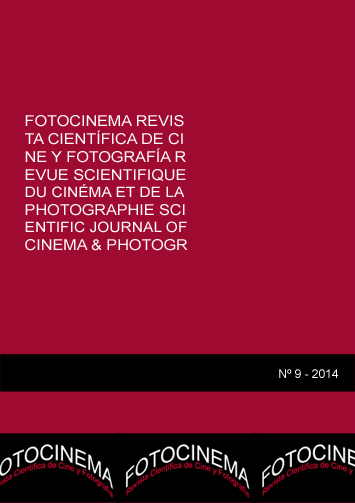El paisajismo observacional de James Benning: la representación de Los Angeles en Los (2000)
DOI:
https://doi.org/10.24310/Fotocinema.2014.v0i9.5961Abstract
El James Benning es uno de los grandes cineastas del paisaje norteamericano. Sus películas se sitúan en la interse-cción entre el cine documental y el experimental, y suelen contrastar el me-dio natural con el medio modificado, el campo con la ciudad y el pasado con el presente, siempre a medio camino entre el esplendor de la modernidad y la de-cadencia post-industrial. Su puesta en escena se basa en la observación atenta del territorio, aunque a veces también incluye elementos performativos.La Trilogia de California (1999-2001), en concreto, propone una cartografía crítica del paisaje californiano a través de sus tres partes –El Valley Centro (1999), Los (2000) y Sogobi (2001)– dedicadas respectivamente a los paisajes rurales, urbanos y naturales. Cada una de estas películas consta de treinta y cinco planos fijos de dos minutos y medio cada uno, un dispositivo minimalista capaz de transmitir mucha información sobre el paisaje, la historia y la sociedad norteamericana, así como sobre la propia vida del cineasta.
El objetivo de este artículo es, por lo tanto, analizar la representación que Benning ofrece de Los Angeles en Los para comprender las características prin-cipales de su estilo, identificado como paisajismo observacional, y las impli-caciones socio-históricas de su discurso.
Abstract:
James Benning is one of the great landscape filmmakers in American cinema. His works are located at the meeting point between documentary and experimental film, and they usually compare the natural and built environment, the country and the city, and the past and the present, always halfway between modernity’s heyday and post-industrial decay. His mise-en-scène is based on the attentive observation of the territory, but sometimes it also includes performative elements.
The California Trilogy (1999-2001), in particular, offers a critical mapping of the California landscape throughout its three parts –El Valley Centro (1999), Los (2000) and Sogobi (2001)– which are respectively devoted to rural, urban and natural landscapes. Each of these works consists of thirty-five two-and-one-half-minute fixed shots, a minimalist device able to convey much information on American landscape, history and society, as well as on the filmmaker’s personal life.
The aim of this paper is therefore to analyse Benning’s representation of Los Angeles in Los in order to understand the main features of his style –which has been identified as observational landscaping– and the socio-historical implications of his discourse.
Palabras clave:
Paisajismo; cine documental; cine experimental; James Benning; trilogia de California; Los Angeles.
Keywords:
Landscaping; Documentary Film; Experimental Film; James Benning; California Trilogy; Los Angeles.Downloads
Metrics
Downloads
Published
How to Cite
Issue
Section
License
All contents published in Fotocinema Revista científica de cine y fotografía are protected under the Creative Commons Attribution-NonCommercial-ShareAlike 4.0 International (CC BY-NC-SA 4.0) license. All about this license is available in the following link: <http://creativecommons.org/licenses/by-nc-sa/4.0>
Users can copy, use, redistribute, share and exhibit publicly as long as:
- The original source and authorship of the material are cited (Journal, Publisher and URL of the work).
- It is not used for comercial purposes.
- The existence of the license and its especifications are mentioned.
There are two sets of authors’ rights: moral and property rights. Moral rights are perpetual prerogatives, unrenounceable, not-transferable, unalienable, imprescriptible and inembargable. According to authors’ rights legislation, Fotocinema. Revista científica de cine y fotografía recognizes and respects authors moral rights, as well as the ownership of property rights, which will be transferred to University of Malaga in open access. The property rights are referred to the benefits that are gained by the use or the dissemination of works. Fotocinema. Revista científica de cine y fotografía is published in an open access form and it is exclusively licenced by any means for doing or authorising distribution, dissemination, reproduction, , adaptation, translation or arrangement of works.
Authors are responsable for obtaining the necessary permission to use copyrighted images.













13.png)




